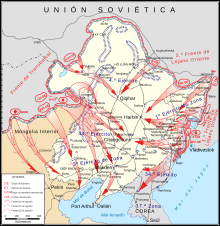187th Rifle Division
At the start of the German invasion it was in reserve in the 45th Rifle Corps, but soon began moving to the front, again joining the Active Army on July 2, 1941.
[4] 2nd Panzer Group renewed its assault on July 10, when two divisions of XXIV Motorized Corps crossed the Dniepr River at and near Bykhaw, 29–32 km south of Mogilev.
After four hours of fighting the XXIV Corps had seized a sizeable bridgehead and, after driving off Soviet forces, began construction of two bridges.
Timoshenko reported that 13th Army was holding at Barsuki and Borkolobovo, with the 187th fighting with German units in the bridgehead; the 137th Rifle Division had now joined 45th Corps.
[6] In the afternoon of July 12 the STAVKA realized that desperate measures were required to restore the situation, including the need to "[c]onduct active operations along the Gomel' and Bobruisk axis to threaten the rear of the enemy's Mogilev grouping."
Only 21st Army scored a partial success when it managed to project a sizeable force across the Dniepr to briefly threaten German communications with Babruysk.
The forces, mostly of 13th Army, that were rapidly being encircled in Mogilev were putting up very stiff resistance against 2nd Panzer Group and included part of the division.
The commander of the defending 61st Rifle Corps, Maj. Gen. F. A. Bakunin, ordered a breakout by his remaining troop overnight on July 26/27, but only a handful managed to reach Soviet lines.
The new commander of the 21st (which was now part of Central Front), Lt. Gen. M. G. Yefremov, requested permission to withdraw his 63rd Rifle Corps back to more defensible positions on the east bank of the Dniepr, but was refused.
28th Corps was defending along the Snov River on and appears to have eliminated a German force that had infiltrated its positions on September 1 but this was of little relevance to the overall situation.
The next day the 187th was reported as fighting intense defensive battles along a line from Gutka Studenetskaya to Mostki, 78–95 km northeast of Chernihiv.
However, he came under some suspicion and was arrested in December 1951, and on October 2, 1952, he was sentenced to 10 years imprisonment, with his rank and his title as a Hero of the Soviet Union revoked.
[20] The Grodelkovskaya Rifle Division began forming on October 23, 1941, in the 1st Red Banner Army of Far Eastern Front, north of Vladivostok.
[22] Following redesignation its order of battle was almost completely different from the 1st formation: The division came under command of Col. Viktor Vasilevich Arkhangelskii on the day it began forming.
This officer would be promoted to the rank of major general on February 22, 1944, but on June 13 he left the division and soon took command of the 4th Fortified Region.
During the early months of 1945 the division received the 458th Self-Propelled Artillery Battalion of 12 SU-76s (plus one T-70 command tank) to supplement its mobile firepower in anticipation of operations in the difficult terrain of Manchuria.
Late on the next day both divisions, in cooperation with a brigade of the 10th Mechanized Corps, pushed the Japanese forces out of Lotzokou and the Taipingling Pass.
[27] On September 19 the 187th was awarded the Order of Suvorov, 2nd Degree, in recognition of its part in the crossing of the Ussuri River and the capture of Mishan, Jilin, Yanji and Harbin.
